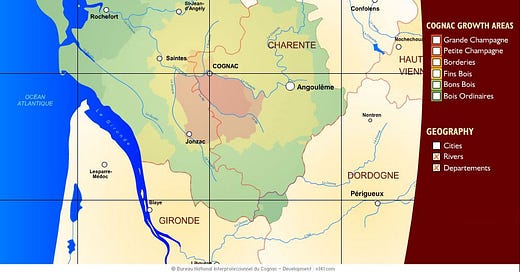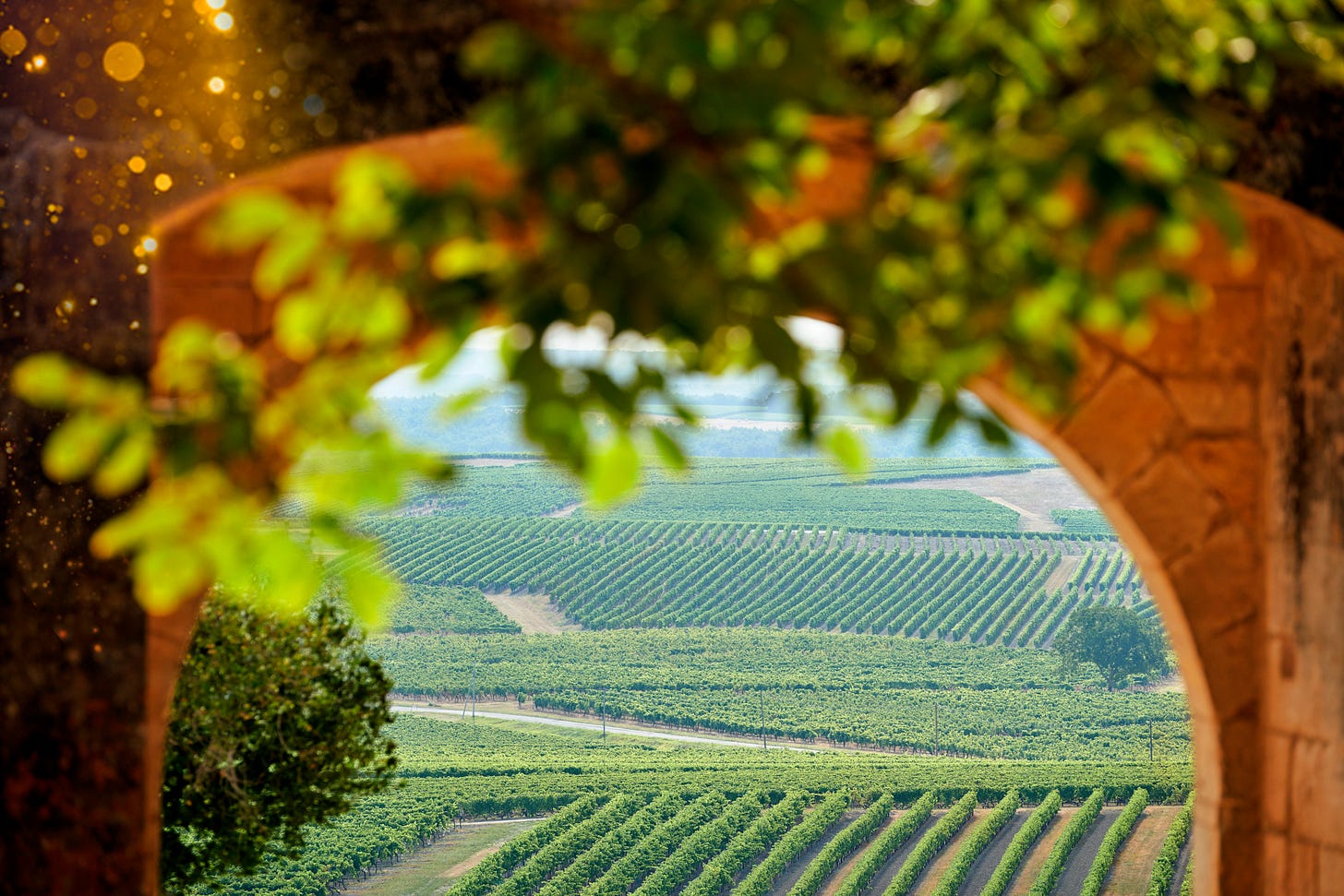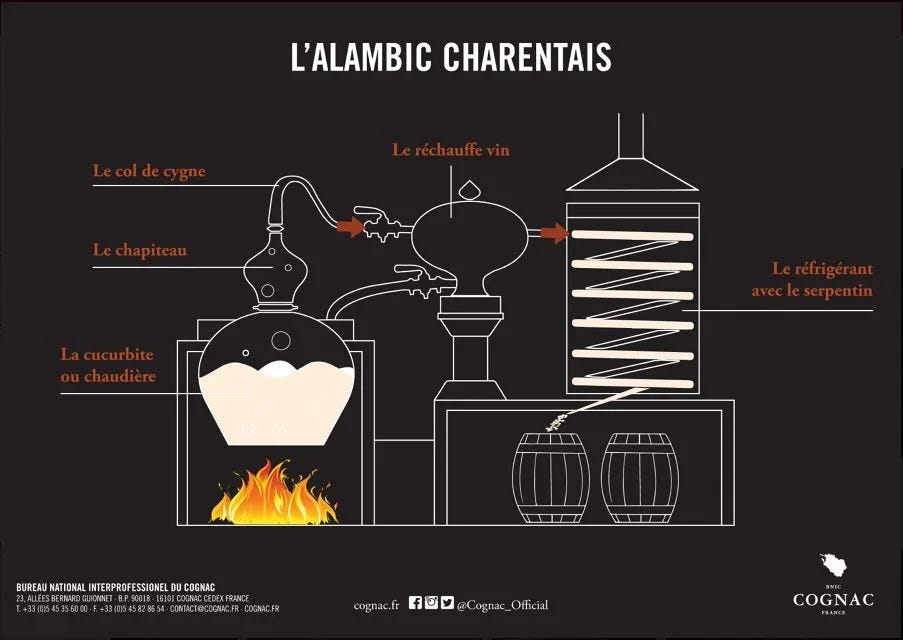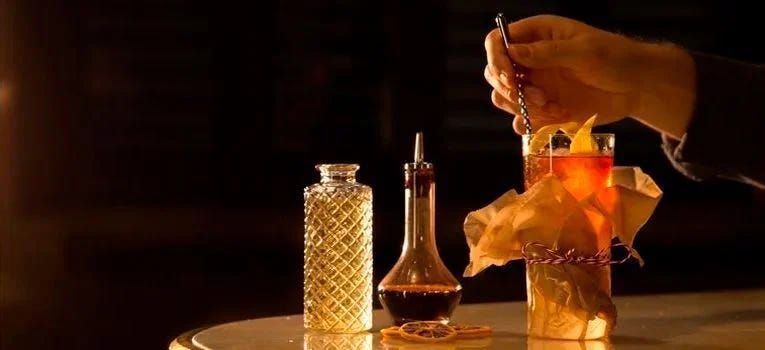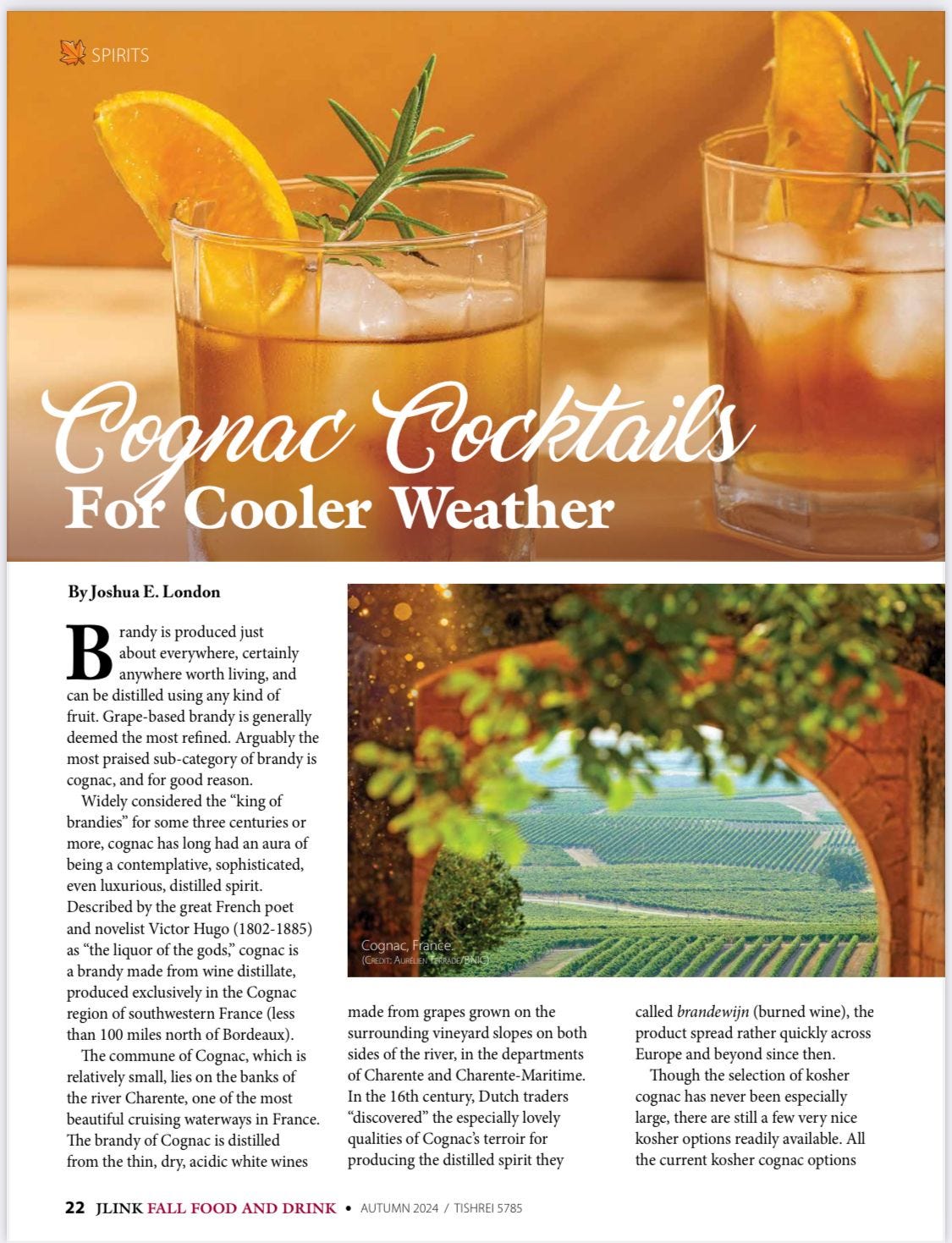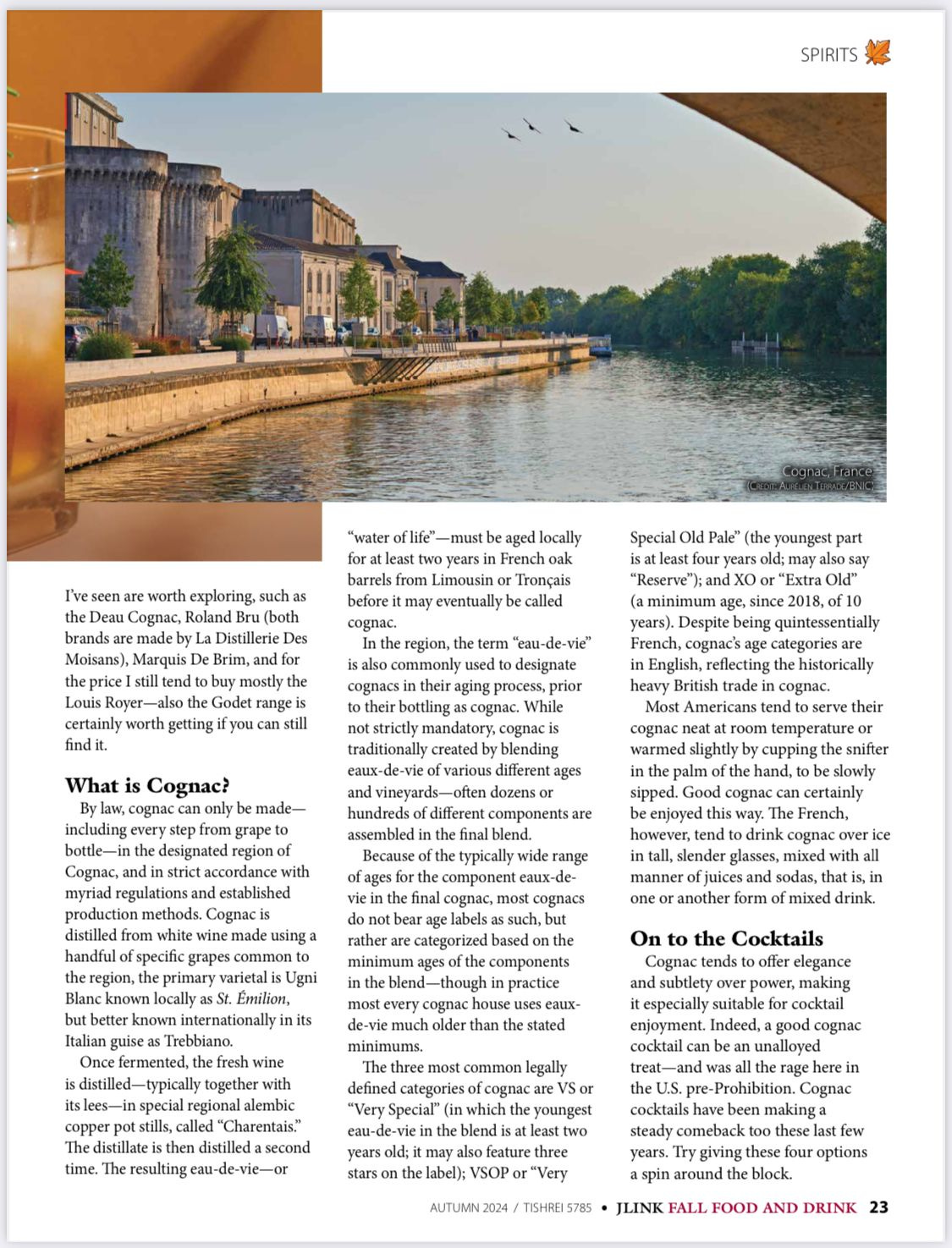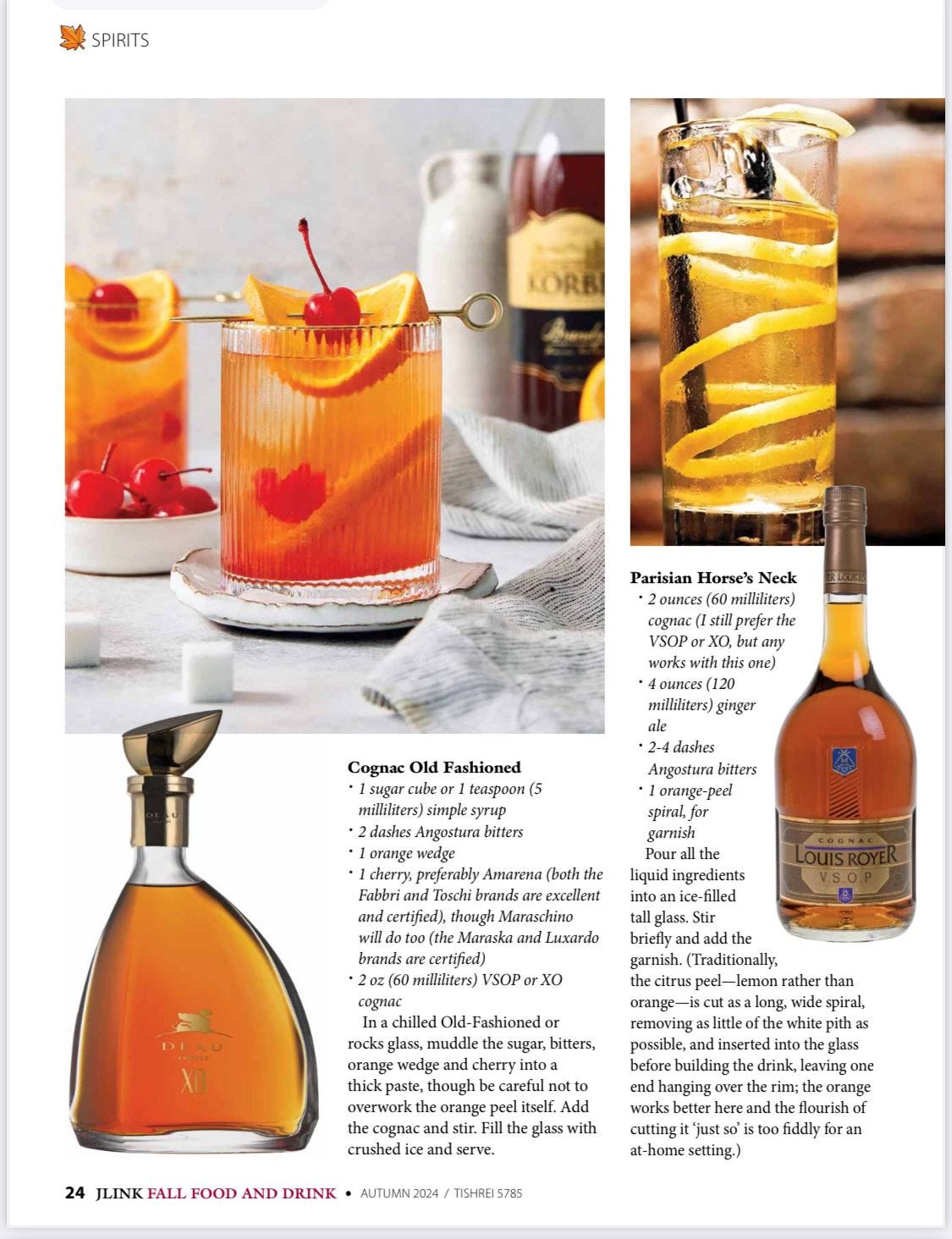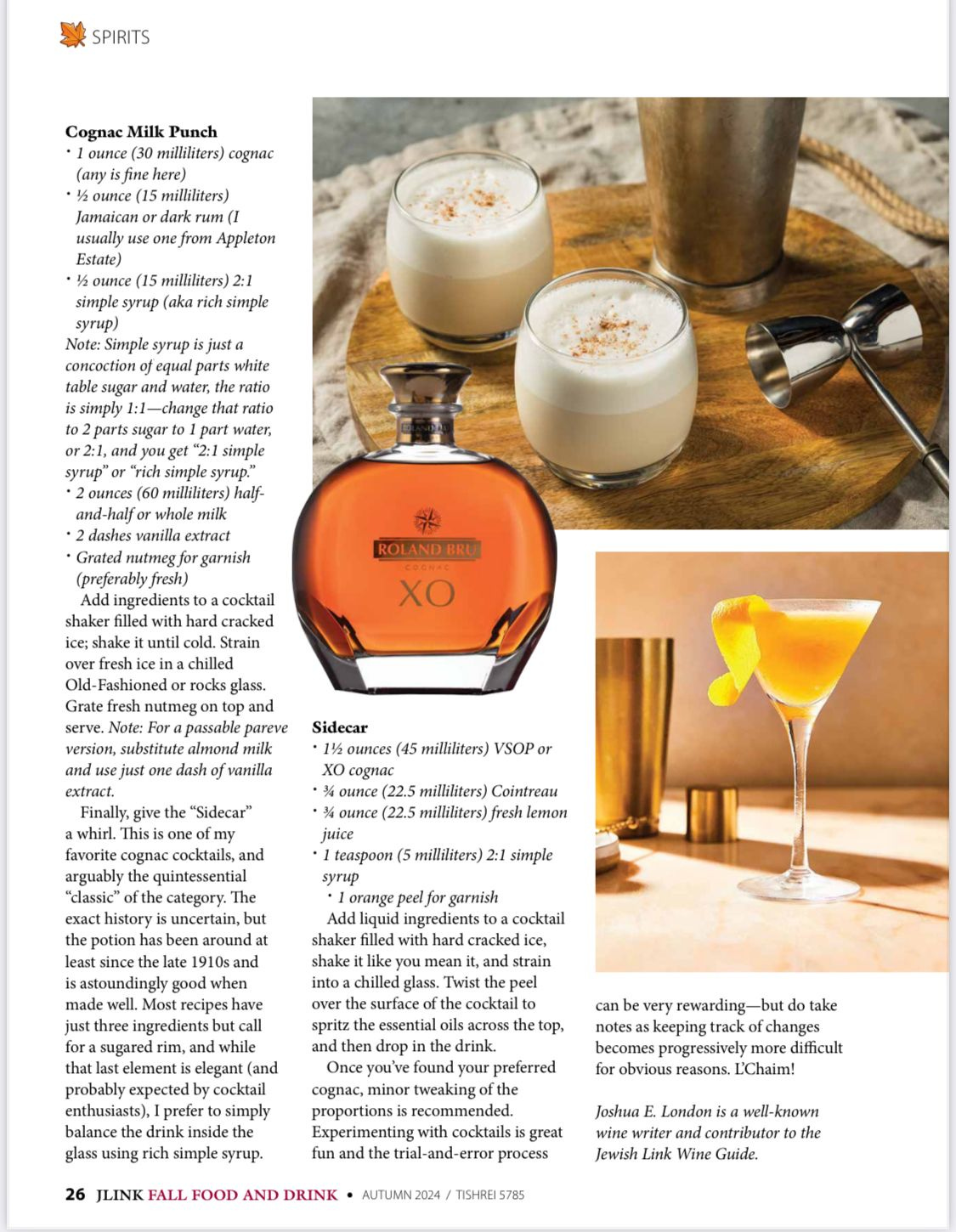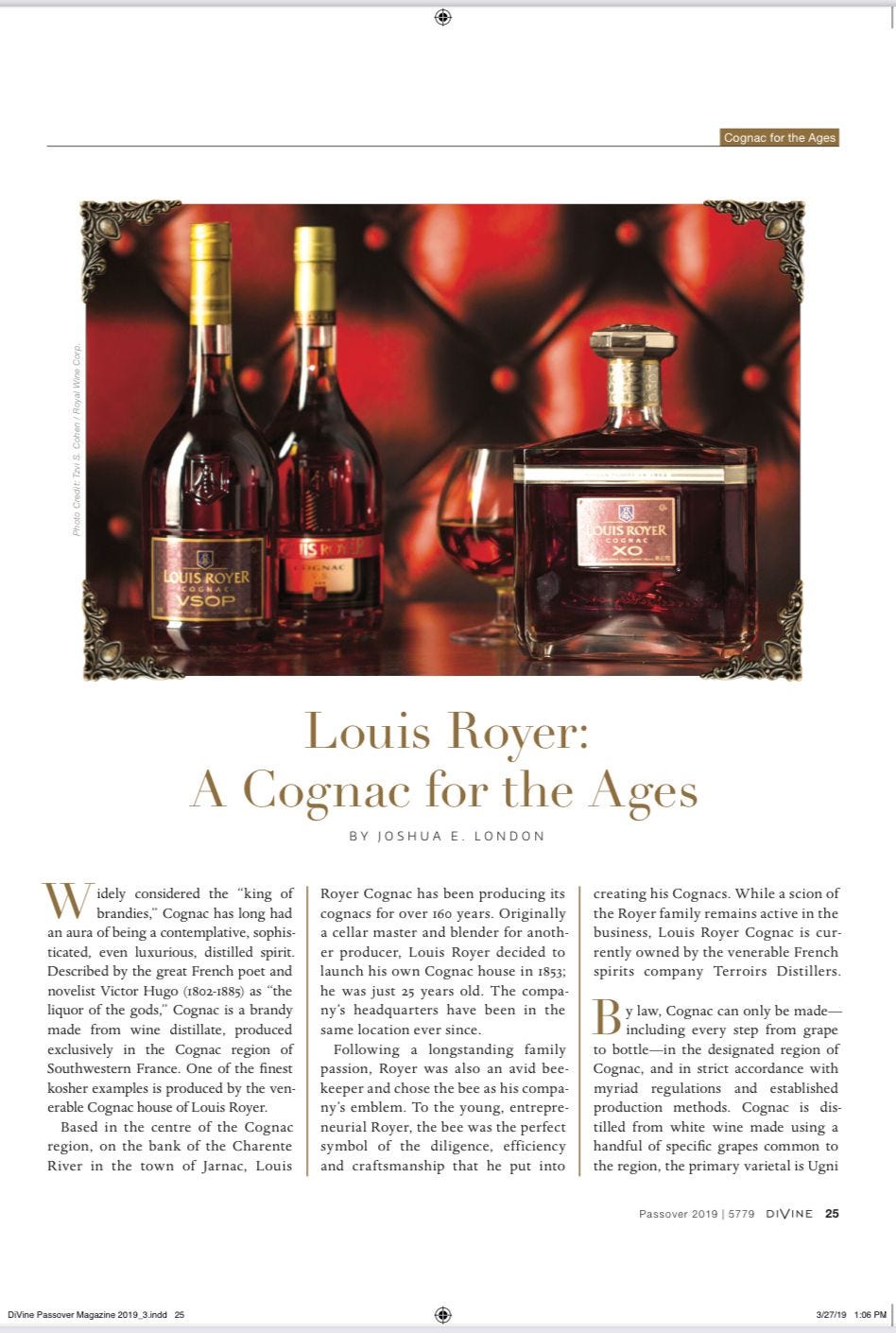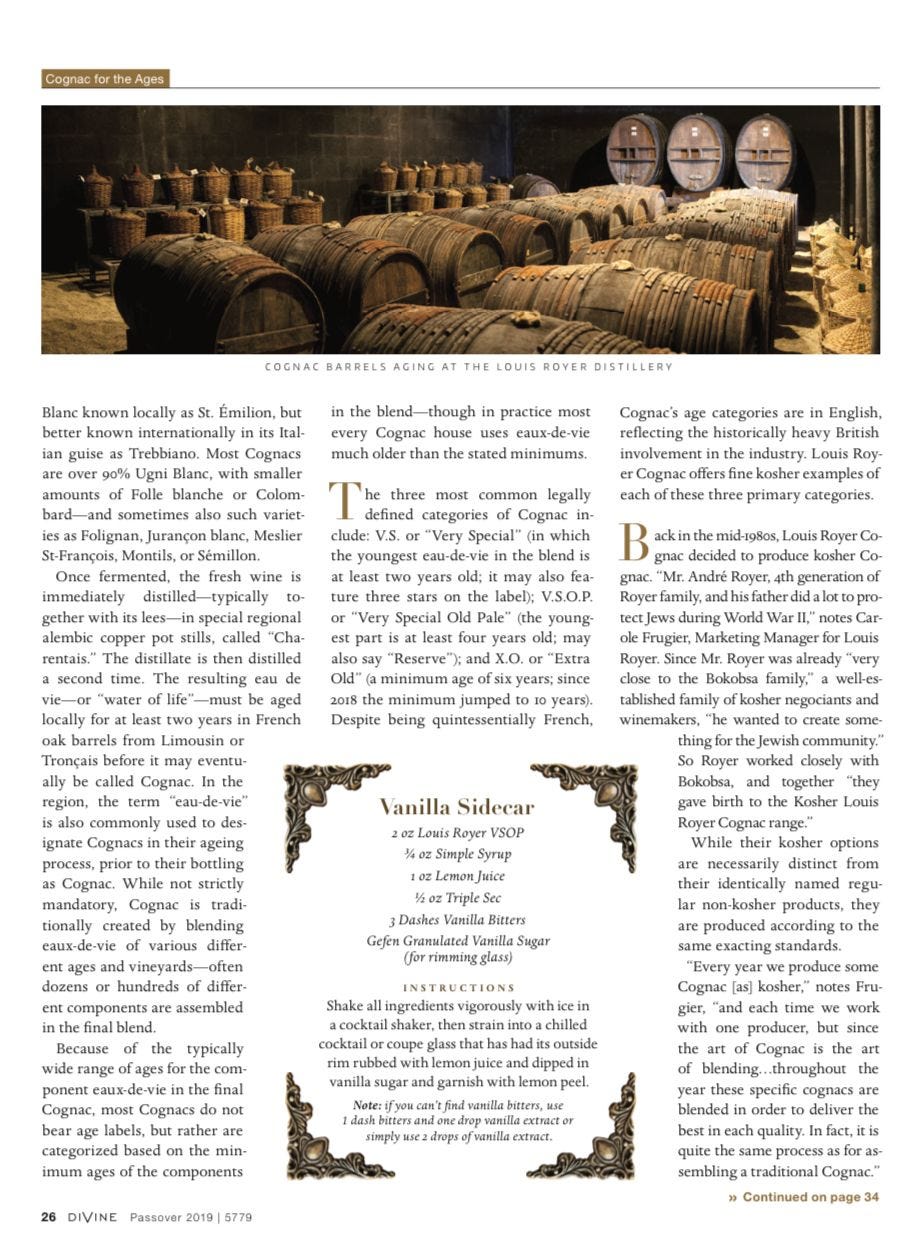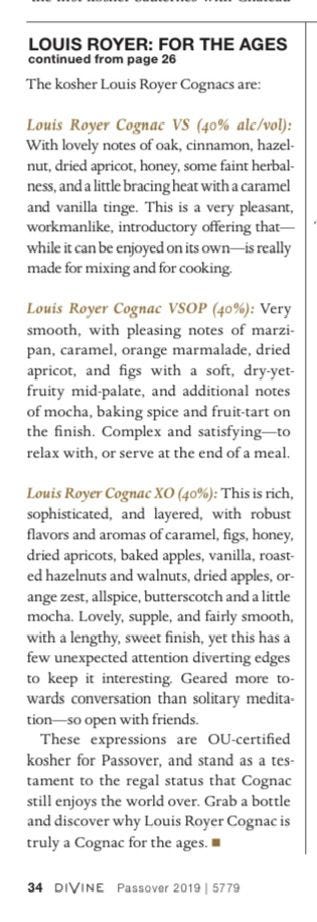Cognac Cocktails
With an extended side-note on the limited kosher-certified releases from Louis Royer Cognac.
NOTE: Oy, I have many articles to catch up on and post here… I will do so in a slightly higgledy-piggledy fashion, though if anyone objects, do let me know.
First up, here is an article that appeared originally—in a slightly shorter form—in the Fall 2024 issue of The Jewish Link Fall Food & Drink magazine, the FlipDocs version of that issue can be read here. Though the “hook” of the piece was for cooler weather, these are great cocktails to be enjoyed whenever the mood strikes. The Louis Royer piece was published in the Passover 2019/5779 issue of DiVine magazine, published periodically by the Royal Wine Corp.
Brandy is produced just about everywhere, certainly anywhere worth living, and can be distilled using any kind of fruit. Turn the fruit into wine and then distill that wine into brandy—simple as that. Grape-based brandy is generally deemed the most refined. Arguably the most praised sub-category of brandy is Cognac, and for good reason.
Widely considered the “king of brandies” for some three centuries or more, Cognac has long had an aura of being a contemplative, sophisticated, even luxurious, distilled spirit. Described by the great French poet and novelist Victor Hugo (1802-1885) as “the liquor of the gods,” Cognac is a brandy made from wine distillate, produced exclusively in the Cognac region of South-Western France (less than 100 miles north of Bordeaux).
The commune of Cognac, which is relatively small, lies on the banks of the river Charente, one of the most beautiful cruising waterways in France. The brandy of Cognac is distilled from the thin, dry, acidic white wines made from grapes grown on the surrounding vineyard slopes on both sides of the river, in the departments of Charente and Charente-Maritime. In the 16th century, Dutch traders “discovered” the especially lovely qualities of Cognac’s terroir for producing the distilled spirit they called brandewijn (burned wine), the product spread rather quickly across Europe and beyond since then.
Though the selection of kosher Cognac has never been especially large, there are still a few very nice kosher options readily available. All the current kosher cognac options I’ve seen are worth exploring, such as the Deau Cognac, Roland Bru (both brands are made by La Distillerie Des Moisans), Marquis De Brim, and for the price I still tend to buy mostly the Louis Royer—also the Godet range is certainly worth getting if you can still find it.
SIDENOTE: Louis Royer’s Kosher production
As noted, the venerable Cognac house of Louis Royer produces several kosher expressions.
Based in the center of the Cognac region, on the bank of the Charente River in the town of Jarnac, Louis Royer Cognac has been producing its cognacs for over 160 years. Originally a cellar master and blender for another producer, Louis Royer decided to launch his own Cognac house in 1853; he was just 25 years old. The company’s headquarters have been in the same location ever since.
Following a longstanding family passion, Royer was also an avid beekeeper and chose the bee as his company’s emblem. To the young, entrepreneurial Royer, the bee was the perfect symbol of the diligence, efficiency and craftsmanship that he put into creating his Cognacs.
While a scion of the Royer family—Jérôme Royer, fifth-generation family member—remains active in the business, Louis Royer Cognac was sold in 1989 to Suntory Holdings Limited (a Japanese multinational brewing and distilling company group), which in turn sold it in 2015 for approximately €100 million to the venerable French spirits company Terroirs Distillers. [The Terroirs Distillers company manages the spirits brands and distilleries of family-owned Picard Vins & Spiritueux.]
Back in the mid-1980s, Louis Royer Cognac decided to produce kosher Cognac in partnership with SIEVA Selection Bokobsa, the now 7th-generation family-run European producer, importer, and distributor of kosher wines and spirits.
“Mr André Royer, 4th generation of Royer family, and his father did a lot to protect Jews during World War II,” noted Carole Frugier, Marketing Manager for Louis Royer. Since Mr. Royer was already “very close to the Bokobsa family,” a well-established family of kosher négociants and winemakers, “he wanted to create something for the Jewish community.” So Royer partnered with Bokobsa, and together “they give birth to the Kosher Louis Royer Cognac range.”
While their kosher options are necessarily distinct from their identically named regular non-kosher products, they are produced according to the same exacting standards.
“Every year we produce some Cognac [as] kosher,” noted Frugier, “and each time we work with one producer, but since the art of Cognac is the art of blending…throughout the year these specific cognacs are blended in order to deliver the best in each quality. In fact, it is quite the same process as for assembling a traditional Cognac.”
The kosher Louis Royer Cognacs are:
Louis Royer Cognac, V.S., kosher edition (40% abv): With lovely notes of oak, cinnamon, hazelnut, dried apricot, honey, some faint herbalness, and a little bracing heat with a caramel and vanilla tinge. This is a very pleasant, workmanlike, introductory offering that—while it can be enjoyed on its own—is really made for mixing and for cooking.
Louis Royer Cognac, V.S.O.P., kosher edition (40%): Very smooth, with pleasing notes of marzipan, caramel, orange marmalade, dried apricot, and figs with a soft, dry-yet-fruity mid-palate, and additional notes of mocha, baking spice and fruit-tart on the finish. Complex and satisfying—to relax with, or serve at the end of a meal, or to make superior cocktails.
Louis Royer Cognac, X.O., kosher edition (40%): This is rich, sophisticated, and layered, with robust flavors and aromas of caramel, figs, honey, dried apricots, baked apples, vanilla, roasted hazelnuts and walnuts, dried apples, orange zest, allspice, butterscotch, and a little mocha. Lovely, supple, and fairly smooth, with a lengthy, sweet finish, yet this has a few unexpected attention-diverting edges to keep it nicely interesting. Geared more towards conversation than solitary meditation—so open with friends. Using this for cocktails gets expensive, but — again — the results are superior.
These expressions are OU-certified kosher for Passover and stand as a testament to the regal status that Cognac still enjoys the world over. Grab a bottle and discover why Louis Royer Cognac is truly a Cognac for the ages.
(and now back to the cocktail article…)
What is Cognac?
By law, Cognac can only be made—including every step from grape to bottle—in the designated region of Cognac, and in strict accordance with myriad regulations and established production methods. Cognac is distilled from white wine made using a handful of specific grapes common to the region, the primary varietal is Ugni Blanc known locally as St. Émilion, but better known internationally in its Italian guise as Trebbiano.
Once fermented, the fresh wine is distilled—typically together with its lees [the sediment of dead yeast cells and other solids that settle at the bottom of a fermentation vessel after wine production]—in special regional alembic copper pot stills, called “Charentais.” The distillate is then distilled a second time. The resulting eau-de-vie—or “water of life”—must be aged locally for at least two years in French oak barrels from Limousin or Tronçais before it may eventually be called Cognac.
In the region, the term “eau-de-vie” is also commonly used to designate Cognacs in their aging process, before their bottling as Cognac. While not strictly mandatory, Cognac is traditionally created by blending eaux-de-vie of various ages and vineyards—often dozens or hundreds of different components are assembled in the final blend.
Because of the typically wide range of ages for the component eaux-de-vie in the final Cognac, most Cognacs do not bear age labels as such, but rather are categorized based on the minimum ages of the components in the blend—though in practice most every Cognac house uses eaux-de-vie much older than the stated minimums.
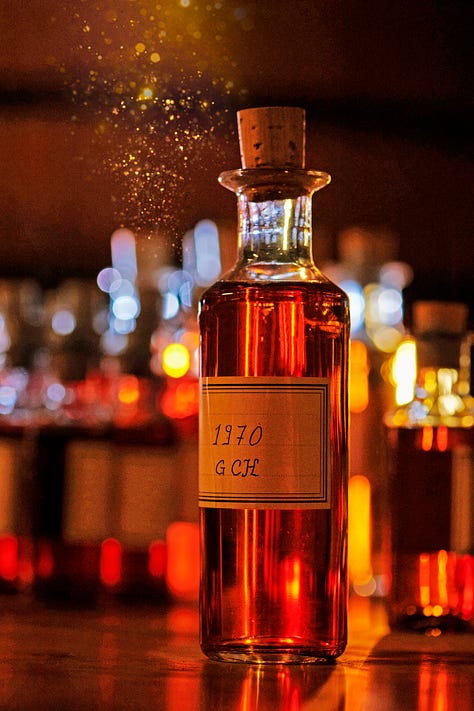
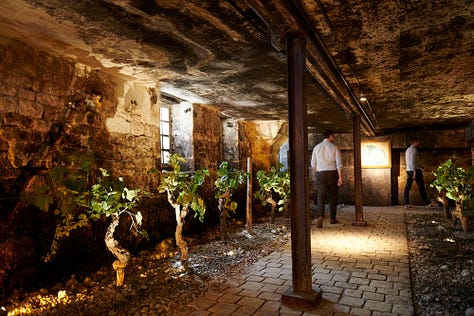

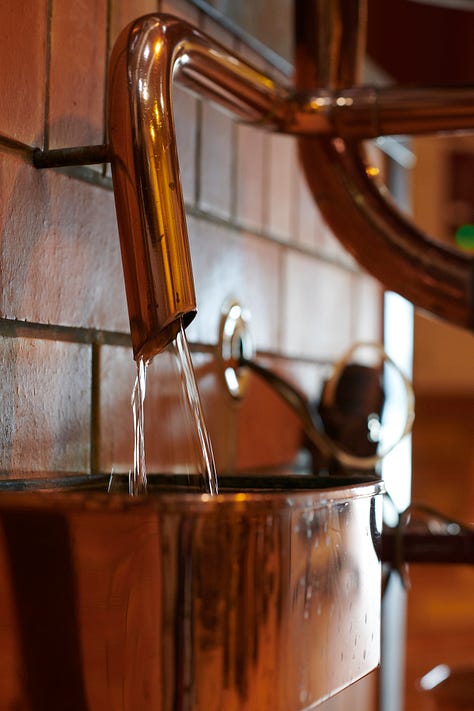
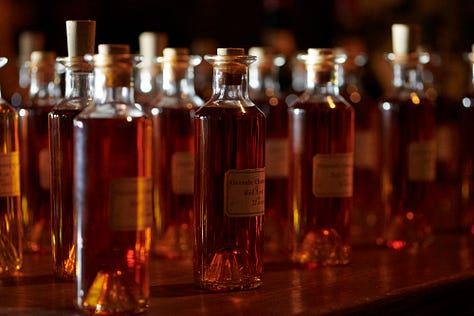
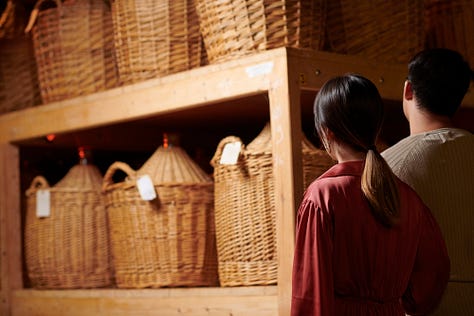
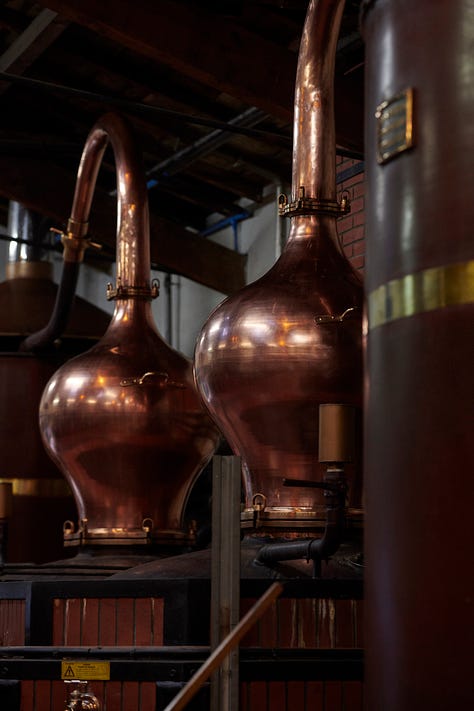

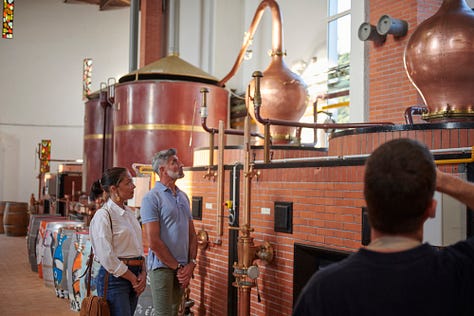
The three most common legally defined categories of Cognac are V.S. or “Very Special” (in which the youngest eau-de-vie in the blend is at least two years old; it may also feature three stars on the label); V.S.O.P. or “Very Special Old Pale” (the youngest part is at least four years old; may also say “Reserve”); and X.O. or “Extra Old” (a minimum age, since 2018, of 10 years). Despite being quintessentially French, Cognac’s age categories are in English, reflecting the historically heavy British trade in Cognac.
Most Americans tend to serve their Cognac neat at room temperature or warmed slightly by cupping the snifter in the palm of the hand, to be slowly sipped. Good Cognac can certainly be enjoyed this way. The French, however, tend to drink Cognac over ice in tall, slender glasses, mixed with all manner of juices and sodas, that is, in one or another form of mixed drink.
On to the Cocktails…
Cognac tends to offer elegance and subtlety over power, making it especially suitable for cocktail enjoyment. Indeed, a good cognac cocktail can be an unalloyed treat—and was all the rage here in the US pre-Prohibition. Cognac cocktails have been making a steady comeback too these last few years. Try giving these four options a spin around the block:
Cognac Old Fashion
1 sugar cube or 1 tsp (5 ml) simple syrup
2 dashes of Angostura bitters
1 orange wedge
1 cherry, preferably Amarena (both the Fabbri and Toschi brands are excellent and certified) though Maraschino will do too (the Maraska and Luxardo brands are certified)
2 oz (60 ml) VSOP or XO Cognac
In a chilled Old-Fashioned or rocks glass, muddle the sugar, bitters, orange wedge, and cherry into a thick paste, though be careful not to overwork the orange peel itself. Add the Cognac and stir. Fill the glass with crushed ice and serve.
Parisian Horse’s Neck
2 oz (60 ml) Cognac (I still prefer the VSOP or OX, but any works with this one)
4 oz (120 ml) ginger ale
2-4 dashes of Angostura bitters
1 orange-peel spiral, for garnish
Pour all the liquid ingredients into an ice-filled tall glass. Stir briefly and add the garnish. (Traditionally, the citrus peel—lemon rather than orange—is cut as a long, wide spiral, removing as little of the white pith as possible, and inserted into the glass before building the drink, leaving one end hanging over the rim; the orange works better here and the flourish of cutting it ‘just so’ is too fiddly for an at-home setting.)
Cognac Milk Punch
1 oz (30 ml) Cognac (any is fine here)
½ oz (15 ml) Jamaican or Dark rum (I usually use one from Appleton Estate)
½ oz (15 ml) 2:1 simple syrup aka rich simple syrup
Note: simple syrup is just a concoction of equal parts white table sugar and water, the ratio is simply 1:1—change that ratio to 2 parts sugar to 1 part water, or 2:1, and you get “2:1 simple syrup” or “rich simple syrup”.
2 oz (60ml) half-and-half or whole milk
2 dashes vanilla extract
Grated nutmeg for garnish (preferably fresh)
Add ingredients to a cocktail shaker filled with hard cracked ice, and shake it until cold. Strain over fresh ice in a chilled Old-Fashioned or rocks glass. Grate fresh nutmeg on top and serve.
Note: For a passable pareve version, substitute almond milk and use just one dash of vanilla extract.
Finally, give the “Sidecar” a whirl. This is one of my favorite Cognac cocktails, and arguably the quintessential “classic” of the category. The exact history is uncertain, but the potion has been around at least since the late 1910s and is astoundingly good when made well. Most recipes have just three ingredients but call for a sugared rim (like a salted rim on a traditional Margarita). While a sugared rim is elegant (and probably expected by cocktail enthusiasts), I prefer to simply balance the drink inside the glass using rich simple syrup.
Sidecar
1½ oz (45 ml) VSOP or XO Cognac
¾ oz (22.5 ml) Cointreau
¾ oz (22.5 ml) fresh lemon juice
1 tsp (5 ml) 2:1 simple syrup
1 orange peel for garnish
Add liquid ingredients to a cocktail shaker filled with hard cracked ice, shake it like you mean it, and strain it into a chilled glass. Twist the peel over the surface of the cocktail to spritz the essential oils across the top, and then drop in the drink.
Once you’ve found your preferred Cognac minor tweaking of the proportions is recommended. Experimenting with cocktails is great fun and the trial-and-error process can be very rewarding—but do take notes as keeping track of changes becomes progressively more difficult for obvious reasons.
L’Chaim!
About Me:
For more than two decades, I’ve been drinking, writing about, consulting on, and speaking professionally about kosher wines and spirits. For over twelve years, I penned a weekly column on kosher wines and spirits that ran in multiple Jewish publications, and my writing continues to appear in a broad range of Jewish and mainstream media, both in print and online.
In addition to writing, I frequently speak publicly, leading tutored tastings and hosting educational programs on kosher wine and spirits appreciation for audiences of all kinds. If you’re interested in commissioning articles, arranging tastings, booking events, or just wanting to connect, feel free to reach out at joshlondon246@gmail.com.
In what now feels like another lifetime, I also authored Victory in Tripoli: How America’s War with the Barbary Pirates Established the U.S. Navy and Shaped a Nation (John Wiley & Sons, 2005), a slice of early American history.
When not immersed in wines and spirits, I work in the charity and non-profit sector. I currently serve as Development Director for Yad Vashem UK Foundation. Previously a longtime Washington, D.C.–based lobbyist and pro-Israel advocate, I relocated to the U.K. with my family during the COVID era—and happily prefer life across the pond, despite the truly lamentable and frankly uncivilized shortage of kosher Beaujolais here. That said, I still make it back to the States from time to time.
